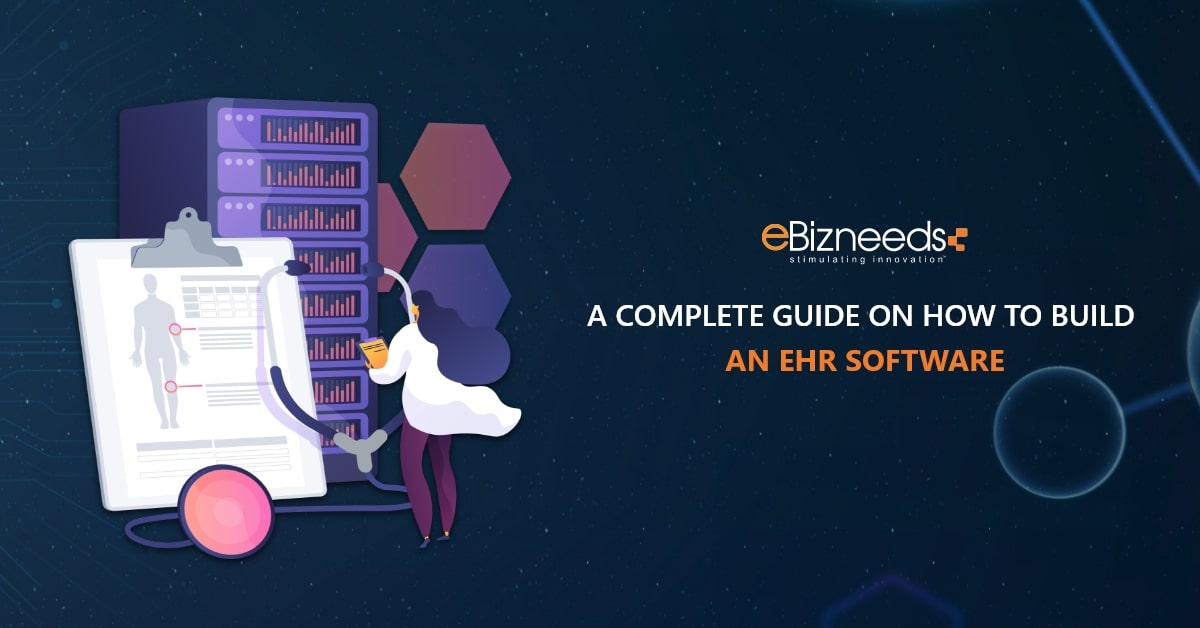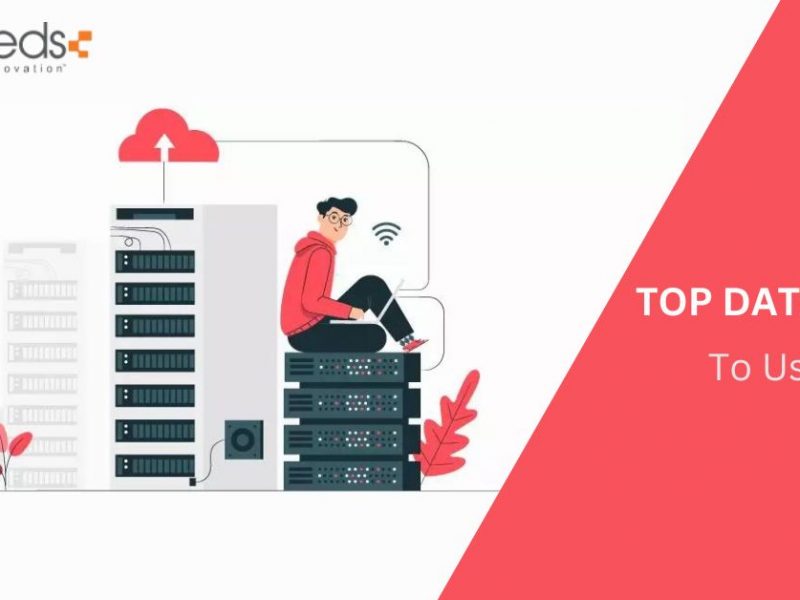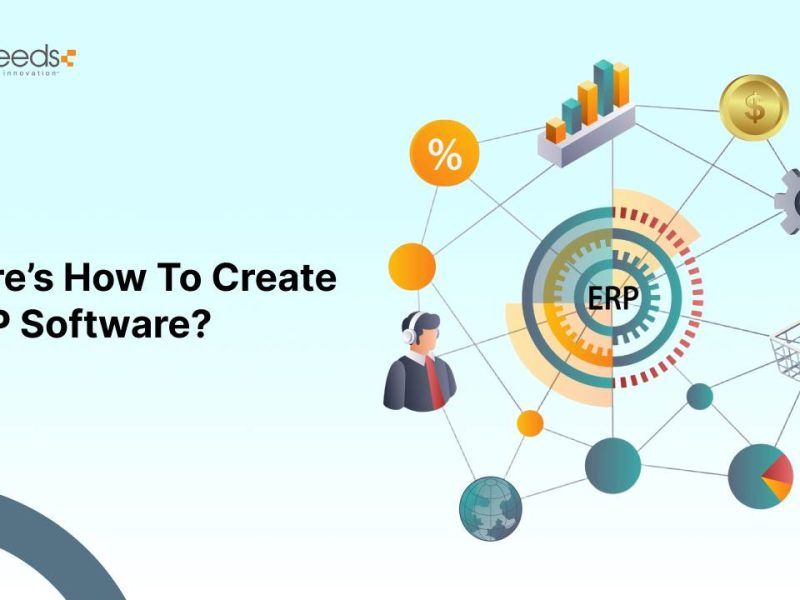The healthcare sector is challenging. So, providing patient safety and quality of care in this challenging environment is more complex than ever before. Hence, healthcare experts focus on developing an EHR software as a telemedicine technology.
EHR aids in the integration of high-quality care and technological advancements. It is used to offer a consistently reliable, usable, and convenient solution to the issues of health record management.
Many might have guessed or known that they are not easy to develop and assist. Hence, creating an understanding of the urgent care EMR system is significant for efficient patient management and streamlined healthcare operations.
This blog will deeply discuss electronic health record systems. Here, we will define the EHR, discuss the benefits of the EHR system, and discuss the features that each EHR software should have as well as how to build an EHR software?.
What is the EHR?
An electronic health record (EHR) is an official health document for individuals that is shared between different agencies and facilities.
The primary role of EHR software is to become more influential as more patient data moves forward to digital and as a greater number of consumers show their desire to consider mobile access related to their health records.
Moreover, an EHR may automate data access and also have the potential to streamline the workflow of clinicians. The EHR has the competency to assist other care-related practices directly or indirectly through different interfaces.
These interfaces are quality management, evidence-based decision assistance, and outcome reporting.
EHR is the next phase of continued healthcare growth that improves the liaison between clinicians and patients.
Also, the provider can make good decisions and give better care if the data is easy to find and updated quickly.
Benefits of Creating EHR Software
EHR Software provides different advantages, such as providing better patient care and automating various tasks. They can be configured and customized as per your medical requirements. The upsurge of EHR software helps in the continuity of care.
Let’s have a look at some significant benefits of developing EHR Software:
Better Quality of Care
Since developing EHR software allows prompt access to a patient record, it aids in offering better care to their patients. It also helps to improve treatment and increase operational efficiency.
EHR software enables physicians to access health analytics that benefit them in addressing patterns. For example, integrating EHR with tools like case management software for social workers ensures comprehensive care by addressing both medical and social needs of patients.
It is how developing EHR Software effectively maintains the quality of care:
- Rapid and straightforward access to a record of patients
- Improves the effectiveness of treatment.
- Aids in the recommendation of possible treatment
- You can make the interaction between physician and patient better.
- Supports the development of preventive care
More Accurate Patient Information
Initially, EHR was introduced as a replacement for paper-based health records. It is built to store the patient’s data and allow easy access. Electronic files have different benefits over paper medical records.
For instance, keeping records on EHR Software reduces the chances of data theft, misplacement, or damage.
Any errors or mistakes caused by handwriting are also lessened with the EHR software. Clinicians can update patient data in real time, leaving them with real patient cases.
Interoperability
EHR software interfaces with other systems, such as electronic medical records. It advances medical activities while maintaining continuity of care.
Along with this, developing an EHR platform that offers physicians interoperability is significant.
Increased Efficiency
EHR not only aids in offering physicians feasible patient records but also saves time. Creating EHR software can accelerate office visits and appointments while maintaining a patient-centric strategy at the same time.
These outcomes show that clinicians and physicians consistently look for more patients than earlier. Artificial intelligence helps to make an EHR platform. It will aid the health provider with diagnosis and interpreting patients’ records.
Increase in Revenue
Each business owner develops a goal to increase revenue. It may be valid from the perspective of a healthcare organization. The EHR System provides payment and billing techniques to manage income and ensure payment completion.
When providing data about a claim, EHR allows physicians to make a document of each patient.
Because the government provides financial incentives to implement EHR, healthcare organisations can earn thousands of dollars to manage the certified solution. EHR software is developed with guidelines and potential obligations.
Must-Have Features of EHR Software
The benefits of implementing an EHR software in a hospital are lavish. Yet, what are the features of EHR software? Let’s explore the must-have features of EHR Software.
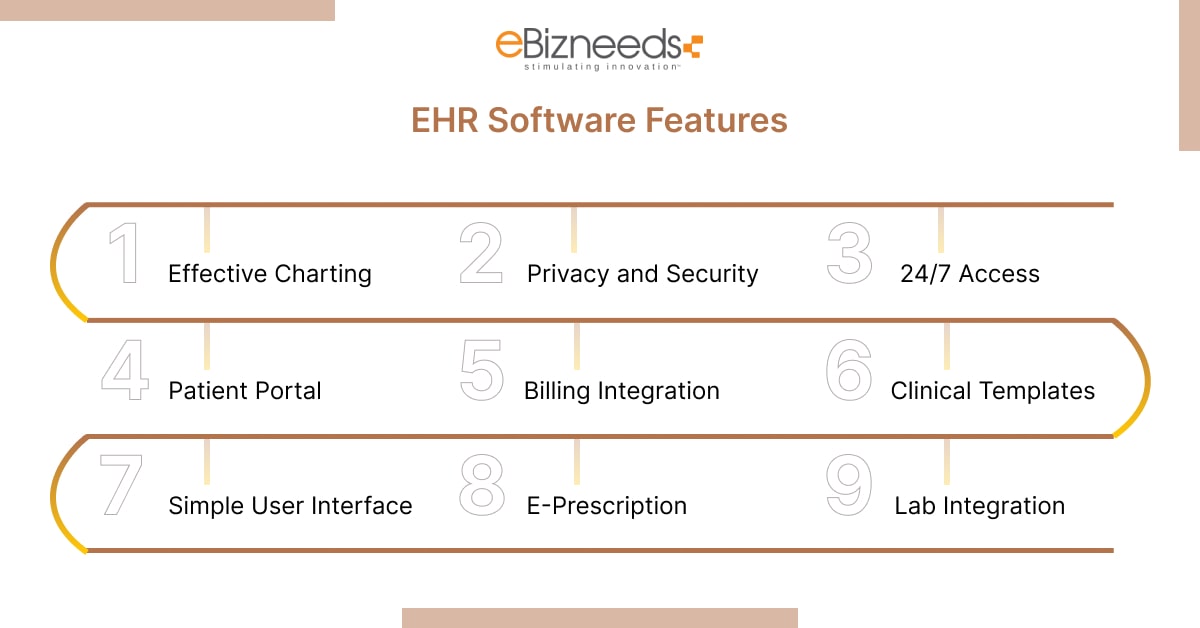

Effective Charting
Deloitte’s survey shows that several physicians prioritize less documentation work and recommend doing it efficiently. Consequently, an EHR solution should provide a significant and stress-free method of charting and recording.
You can consult the mobile app development company to get assistance for effective charting.
Another thing you can do in developing EHR software is to improve charting significantly with machine learning and AI. In addition, AI develops more innovative applications because It gains knowledge from user behaviour to provide data.
Besides, AI can be used in EHR to understand past medical data and help with suggestions for auto-filling.
Privacy and Security
Fundamentally, the most important aspect to take into account while creating EHR software is security. Protected Health Information (PHI) stores and transmits confidential patient health data that must be kept secure at all costs.
In this context, the EHR software should follow the instructions cited in HIPAA (the Health Insurance Portability and Accountability Act).
Following are specific tips for developing your EHR software HIPAA-compliantly:
- By transmitting PHI over the HTTP network, you can ensure its security. It is a secure communication technology that uses TLS or SSL to encrypt the data into meaningless characters.
- Clearly state the architecture’s and the app’s security requirements. A certified security expert should exercise caution when it comes to HIPAA.
24/7 Access from Anywhere
Users should have access to the EHR solution at all times and from any location. Making sure your EHR is compatible with various browsers, operating systems, and devices is unavoidable.
The majority of productivity software is web-based, including EHR software development. When developing EHR, you must make sure the programme works with popular browsers including Safari, Chrome, and Internet Explorer.
Furthermore, the user experience shouldn’t be restricted to particular platforms.
You should ensure that building EHR software considers the system’s screen size, whether it is a tablet, mobile device, or PC.
Patient Portal
Developing EHR software should offer utility to clinics, practitioners, and patients. Hence, sophisticated features are required in a dedicated patient portal.
The patients can log in, access their health information, and take the appropriate action. An on-demand app development company can assist in the creation of an effective patient portal.
A patient portal commonly considers the following:
- Access to treatments
- Lab tests with outcomes
- Reports (like hospital discharge descriptions)
- Insurance data
- Each visit history
- Billing and payment data
- Allows you to book appointments at your leisure.
- built-in messenger for communicating with clinicians and other healthcare professionals
- Download the forms to fill out.
Billing Integration
An efficient EHR offers patients and practitioners a stress-free and quick billing system. It eliminates need for time-consuming manual data entry, reduces typing errors, and creates a centralised system by eliminating the need for additional billing software.
You need to maintain transparency between patients and practitioners, where patients can access the billing data and practitioners have access to the patient count. There is a single location for all claims, paid or unpaid.
Clinical Templates
A reliable EHR system enables practitioners to create templates that may be used to patients with similar conditions. By removing time-consuming activities, it can free up clinicians’ time so they can check on more patients.
Simple User Interface
While practitioners spend more time on the software, an intuitive and straightforward user interface is a must-have feature. Certain principles are considered in designing EHR user interfaces, such as navigation, interaction, functionality, cognition, and display.
E-Prescription
Instead of making hand notes, it enables doctors to draught and send prescriptions electronically to pharmacies or patients. There are various advantages to implementing the e-prescription function in EHR, including saving records of prescribed medications, sending timely refill reminders, and reducing errors.
Lab Integration
Because they are essential for disease diagnosis, treatment, and management, laboratory reports have a moderately large impact. Furthermore, the procedure is sped up by integrating EHR with labs.
Through the EHR software, practitioners can directly access the test findings and make important patient care decisions.
We can transmit and receive reports electronically to help us make quick judgments thanks to the lab integration feature’s connectivity with other pieces of software.
Tech Stack for EHR Software Development
The chosen technology should serve the sole objective of developing a dependable, accessible, and service-oriented design. Moreover, this design should ensure health information technology interoperability.
Hiring an EHR Software development company makes competent to you for coherent interpretation, interchange, and data usage between different systems.
To develop a modern service-oriented design, the app should be categorized into modules that interact with one another through a REST API. These modules can be related to different healthcare app development services, such as billing and charting.
This design form permits improved app scalability, isolation, precise fault detection, simplified system maintenance, and recovery. A development team can also ensure that healthcare laws like GDPR, PCI-DSS, HITECH, PIPEDA, and HIPAA are followed.
|
Languages |
Python, C++, Swift, Java, Kotlin, Ruby, JavaScript, PHP, C# |
|
SDKs |
Android, Flutter, and iOS |
|
Frameworks and libraries |
Angular, Django, jQuery, React, Node.js, Vue.js, Laravel, and Bootstrap |
|
Web server |
Nginx, Apache |
|
Databases |
PostgreSQL, MySQL, MongoDB, and Redis |
|
Analytics |
Amazon EMR, Google Analytics |
|
Messaging |
ActiveMQ, RabbitMQ, and Apache Kafka |
|
Utilities |
Cloudflare, Celery, Elasticsearch, and Amazon S3 |
|
Hosting |
Azure, AWS, GCP, and Vultr |
|
Payment gateway |
Stripe, PayPal, ACH Payments, and Skrill |
Cost of Creating An EHR Platform
The total cost of execution is still a major problem for many healthcare businesses, regardless of whether you want to develop an EHR software or implement a medical app in clinics.
Since the final cost will vary according to the features you include in the system, it is impossible to estimate the EHR development budget precisely.
Depending on whether you select an on-site or web-based system, the installation and purchase cost of EHR will typically between $15,000 and $70,000.
Additionally, a cloud-based EHR would have recurring monthly charges like subscription fees. However, the on-site EHR software needs ongoing support and supervision.
Moreover, both Android and iPhone app development Services are necessary for efficient EHR software development.
Hence, you can hire iPhone app developers to select iOS app development services for developing EHR software and Android app developers for Android app development services.
However, five key factors will influence the expenses when estimating the budget for EHR execution, including:
- Hardware requires considering database servers, desktop computers, scanners, printers, tablets, and laptops.
- Software: It considers the EHR apps, interface modules, and upgrades. The software expenses will also depend on the deployment technique; hence, hiring android app developers can be your best choice.
- Implementation involves the IT contractor, attorney, chart conversion, electricians, redesigning assistance, installation, and consultation assistance.
- Training: You need to provide implementation training for developing EHR software, which can be moderately expensive. Training is required for office staff, surgeons, nurses, and other doctors.
- Ongoing costs include maintenance and network fees like internet, communication, support, and agreement costs.
How Do I Build EHR software?
Now that we have discussed the cost of developing EHR software Let’s move on to address the stages of development. We will initiate with idea validation and move towards testing and prototyping.
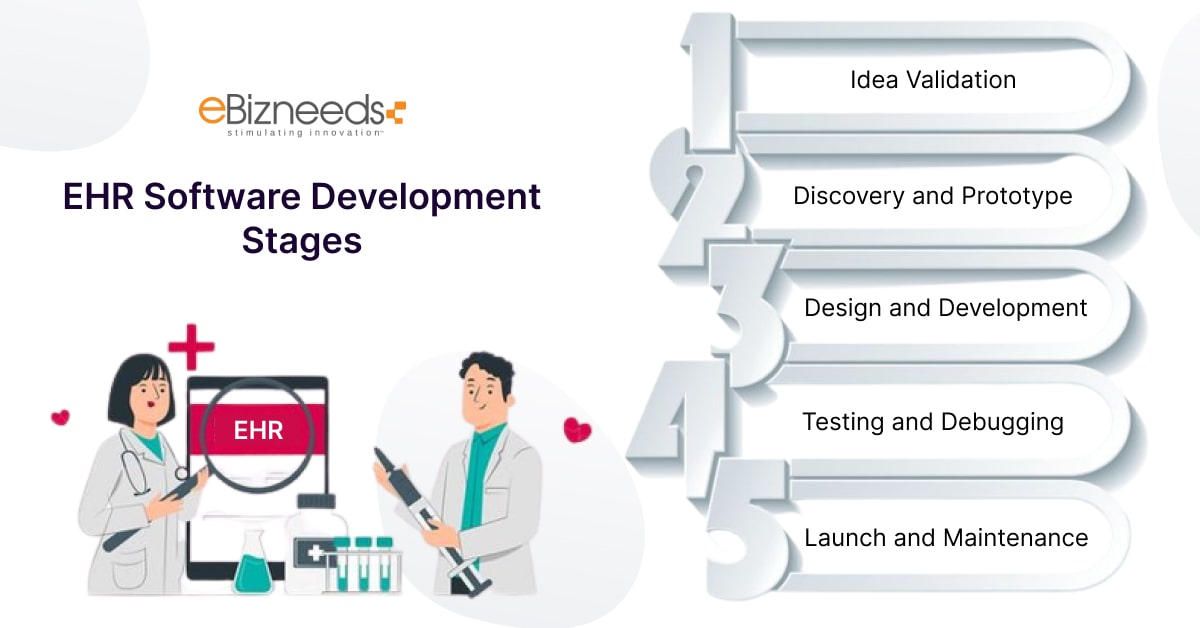

Idea Validation
Before understanding how to develop EHR software, we will assess its validity. We do get different requests from our clients regarding custom EHR software development.
After this, we evaluate its probability and potential to achieve success. We need to ensure that we can handle the development related to the customized EHR system.
You can initiate with an understanding of the client’s needs. Make a list of questions related to the development procedure. Asking such questions from the clients aids us in getting an affordable idea regarding what they are looking for. It makes clear the expectations of clients from their EHR software.
Moving forward, it is critical to understand the user’s pain points. For instance, what concerns do clinic practitioners and physicians face?
- How about interaction with the patients and other doctors?
- Is it more difficult for them to complete forms?
Asking such questions would get you closer to understanding the client’s wants. Afterward, you will have better knowledge regarding how to develop an EHR.
Discovery and Prototype
Let’s move to the next step: discovery and prototyping to build EHR software. Under this, you must develop a flowchart of the procedures and processes.
It considers addressing the features of EHR software to the development team. Identifying the technology stack is significant. You can hire a healthcare app development company to decide on the best technologies here. EMR software development also includes the estimation of cost.
After completing the business analysis and estimation, we can create EHR software. You need to develop a prototype to comprehend how the software works initially. Moreover, it will help you to know how to make it better.
Design and Development
Next, you need to design and develop EHR software. You can hire dedicated developers to create a basic design of EHR software according to the specification. Moving forward, we will decide how to develop the first design of a solution.
With the support of service-oriented design, you can develop modules related to significant segments. To build EHR software, the development of such modules is required. Let’s check out what these are:
- It will support streamlining the tasks.
- We can rapidly track the development procedure.
- You can conduct efficient screening as well as performance assessments.
When developing EHR software in the above manner, scalability is much easier.
Testing and Debugging
During the testing phase, the quality assurance team will address the bugs. They go through the development phase, identify the design, and review other operations. They also understand how to develop a better version of EHR software.
Launch and Maintenance
The procedure to develop EHR software is specific to the requirements of users. Hence, we launch the product in a feasible market. It aids us in comprehending where and how to make transformations in the final version.
Initially, you need to launch the MVP version. The motive is to assess the performance and also get feedback. Some insights make it easier to modify the features of EHR software development.
We can scale up the current features by adding, removing, or editing them.
How to Make EHR Software HIPAA Compliant
Many people are confused about HIPAA and EHR because there is no complete and all-inclusive checklist. HHS was cautious not to be too specific because security is highly complex and technology is evolving rapidly, and consequently, it doesn’t provide detailed lists.
Let’s delve a bit more into the key aspects that will assist you in getting started.
You have to be highly cautious and deliberate regarding accessing data. It is essential to ensure that your employees only get access to the data they require and nothing more.
For example, an X-ray expert must check information associated with the process they are performing, such as past injuries. But the expert doesn’t require checking complete medical records or personally identifiable data such as the patient’s phone number or address.
Authentication
A user can log into your EMR anytime, and you must ensure that it is the same user as the account. It is known as authentication. Only after the system authenticates can the user access ePHI to check their records.
The security rule emphasizes three kinds of authentication:
- Password and PIN code
- A distinctive item that a user holds, such as a security key, code, or token
- Biometrics such as voice patterns, fingerprints, and facial patterns
Automatic Logoff
To avoid unauthorized access, your workforce must always log off once they leave their workstation. Because we are human beings, the probability of forgetting to do is higher. That’s why it is significant to consider automatic logoff in your EHR; hence, a session is ended automatically after a specific time while the system is not used.
Audits and Alerts
You must understand any breach or violation as soon as it happens so you can take timely measures. You can secure ePHI if you know what happens to it at all times, who accesses it, what action a user takes, and if they are authorized to perform it.
Therefore, audit trail functionality must be considered when developing EHR software that automatically logs each user task.
Encryption
HIPAA stipulates that you must encrypt your patient data whenever it is at a higher risk. The need is addressable, meaning it is up to you to choose if you need to encrypt data and what measures and when you conduct it.
Although encryption is not mandatory, you still need good reasons not to complete it, which must be documented. Moreover, this documentation will be accessible in the case of destruction or breach, like the theft of a computer with ePHI.
HIPAA-Compliant Hosts and Infrastructure
While making your custom EMR system, you need to decide where it will be hosted and ensure that the hosting is compliant.
A HIPAA-compliant ePHI storage and infrastructure indicate that the data has to be secured in every possible manner, including:
- Physically, you can secure the servers with locks, alarms, doors, and video surveillance.
- Administratively, you can strictly control the servers and initiate feasible policies and processes for the personnel.
- Technically, you can enable server software security and reliable recovery and backup.
Conclusion
As aforementioned, we have discussed how to create EHR software, and each aspect is significant. Whether it is idea valuation or using feasible technologies and testing, completing all such tasks helps develop EHR software.
The regulatory bodies also assist and promote this software in hospitals. In addition, good EHR software can make a significant difference to the business.
You can hire dedicated developers as they know the nuances of how to build an effective platform. They also understand the significance of a sound system.
It helps rationalize the administrative system and supports the management and processing. The process of developing EHR software helps healthcare institutions to succeed and grow.
It will also aid them in learning how to create effective EHR software. These systems have a great return on investment when the implementation is accurate.



Naveen Khanna is the CEO of eBizneeds, a company renowned for its bespoke web and mobile app development. By delivering high-end modern solutions all over the globe, Naveen takes pleasure in sharing his rich experiences and views on emerging technological trends. He has worked in many domains, from education, entertainment, banking, manufacturing, healthcare, and real estate, sharing rich experience in delivering innovative solutions.
